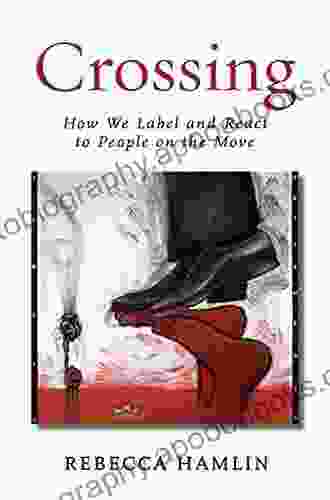How We Label and React to People on the Move: A Comprehensive Exploration

4.5 out of 5
| Language | : | English |
| File size | : | 1646 KB |
| Text-to-Speech | : | Enabled |
| Screen Reader | : | Supported |
| Enhanced typesetting | : | Enabled |
| Word Wise | : | Enabled |
| Print length | : | 218 pages |
In an increasingly interconnected world, human mobility has become a defining feature of our time. People are moving across bFree Downloads for a variety of reasons, including conflict, persecution, economic opportunity, and family reunification. As a result, we are witnessing unprecedented levels of migration and displacement, which have had a profound impact on societies around the globe.
One of the most striking aspects of this global movement of people is the way in which we label and react to those who are on the move. We often categorize people based on their migration status, such as "migrant," "refugee," or "asylum seeker," and these labels can have a significant impact on how we perceive and treat them.
In this article, we will explore the complex societal phenomena of labeling and reacting to people on the move. We will examine the historical and contemporary contexts that shape our perceptions and responses to migrants, refugees, and other mobile populations. Through an interdisciplinary lens, we will provide insights into the psychological, social, political, and economic factors that influence how we categorize and treat people based on their mobility status. We will also discuss the ethical implications of our labeling practices and suggest ways to foster a more just and compassionate society for all.
The Historical Context of Labeling and Reacting to People on the Move
The labeling and categorization of people on the move has a long and complex history. In many cultures, migrants and refugees have been viewed with suspicion and hostility. This is often due to fears about the impact of migration on local communities, such as competition for jobs and resources. In some cases, these fears have led to discrimination and violence against migrants and refugees.
In the modern era, the labeling of people on the move has been shaped by a number of factors, including globalization, the rise of nationalism, and the spread of misinformation. Globalization has led to increased movement of people across bFree Downloads, which has in turn led to increased awareness of the challenges facing migrants and refugees. However, it has also led to increased competition for jobs and resources, which has fueled anti-immigrant sentiment in some countries.
The rise of nationalism has also contributed to the labeling and categorization of people on the move. Nationalism is based on the idea that people who share a common language, culture, and history should have their own nation-state. This can lead to a sense of us versus them, in which people who are not part of the nation-state are seen as outsiders and a threat.
Finally, the spread of misinformation has also played a role in the labeling and categorization of people on the move. In recent years, there has been a rise in misinformation about migrants and refugees, which has been spread through social media and other channels. This misinformation has contributed to negative perceptions of migrants and refugees, and has made it more difficult for them to find acceptance and support.
The Psychological and Social Factors that Influence Our Reactions to People on the Move
In addition to the historical and contemporary contexts that shape our perceptions and responses to people on the move, there are also a number of psychological and social factors that influence our reactions. These factors include our own personal experiences with migration, our social networks, and our exposure to media portrayals of migrants and refugees.
Our own personal experiences with migration can have a significant impact on how we view and react to people on the move. If we have had positive experiences with migrants or refugees, we are more likely to be welcoming and supportive of them. However, if we have had negative experiences, we may be more likely to view them with suspicion or hostility.
Our social networks can also influence our reactions to people on the move. If we are surrounded by people who are open and accepting of migrants and refugees, we are more likely to share those views. However, if we are surrounded by people who are hostile or suspicious of migrants and refugees, we may be more likely to adopt those views.
Finally, our exposure to media portrayals of migrants and refugees can also influence our reactions. If we are constantly exposed to negative portrayals of migrants and refugees, we are more likely to believe that they are dangerous or a threat. However, if we are exposed to more positive portrayals, we are more likely to see them as human beings who are fleeing violence or persecution.
The Ethical Implications of Labeling and Reacting to People on the Move
The way in which we label and react to people on the move has a number of ethical implications. First, it can have a significant impact on their well-being. When we label people as "migrants," "refugees," or "asylum seekers," we often create a sense of otherness that can lead to discrimination and violence. This can make it difficult for people on the move to find safety, shelter, and work.
Second
4.5 out of 5
| Language | : | English |
| File size | : | 1646 KB |
| Text-to-Speech | : | Enabled |
| Screen Reader | : | Supported |
| Enhanced typesetting | : | Enabled |
| Word Wise | : | Enabled |
| Print length | : | 218 pages |
Do you want to contribute by writing guest posts on this blog?
Please contact us and send us a resume of previous articles that you have written.
 Book
Book Novel
Novel Page
Page Chapter
Chapter Text
Text Story
Story Genre
Genre Reader
Reader Library
Library Paperback
Paperback E-book
E-book Magazine
Magazine Newspaper
Newspaper Paragraph
Paragraph Sentence
Sentence Bookmark
Bookmark Shelf
Shelf Glossary
Glossary Bibliography
Bibliography Foreword
Foreword Preface
Preface Synopsis
Synopsis Annotation
Annotation Footnote
Footnote Manuscript
Manuscript Scroll
Scroll Codex
Codex Tome
Tome Bestseller
Bestseller Classics
Classics Library card
Library card Narrative
Narrative Biography
Biography Autobiography
Autobiography Memoir
Memoir Reference
Reference Encyclopedia
Encyclopedia John Thompson
John Thompson Michael Fabey
Michael Fabey J L Weil
J L Weil Lindsay Buroker
Lindsay Buroker Scott Mcdougal
Scott Mcdougal Tanfer Emin Tunc
Tanfer Emin Tunc Anna Nadler
Anna Nadler Rebecca Hamlin
Rebecca Hamlin Alan Young
Alan Young Jean Adrienne
Jean Adrienne Shelley Cohen Konrad
Shelley Cohen Konrad Arlem Hawks
Arlem Hawks Bruce E Stewart
Bruce E Stewart Linda J Hahn
Linda J Hahn Florence Littauer
Florence Littauer Edwin Felix
Edwin Felix Lamis Elmy Abdelaaty
Lamis Elmy Abdelaaty Will Bunch
Will Bunch Aleks Harrison
Aleks Harrison Akheel Mohammad
Akheel Mohammad
Light bulbAdvertise smarter! Our strategic ad space ensures maximum exposure. Reserve your spot today!

 Clayton HayesUnlock the Power of Politics with Akinyele Omowale Umoja's Groundbreaking...
Clayton HayesUnlock the Power of Politics with Akinyele Omowale Umoja's Groundbreaking...
 Jack ButlerEmthy Kind Connect: Poetry Painting Beyond: A Poetic and Visual Journey into...
Jack ButlerEmthy Kind Connect: Poetry Painting Beyond: A Poetic and Visual Journey into...
 Jayden CoxUnveiling the Secret World of Cats: Excerpts from My Cat Diary, a Captivating...
Jayden CoxUnveiling the Secret World of Cats: Excerpts from My Cat Diary, a Captivating... Colton CarterFollow ·8.9k
Colton CarterFollow ·8.9k Deacon BellFollow ·17.7k
Deacon BellFollow ·17.7k Floyd RichardsonFollow ·8k
Floyd RichardsonFollow ·8k Matt ReedFollow ·8.5k
Matt ReedFollow ·8.5k John SteinbeckFollow ·12.1k
John SteinbeckFollow ·12.1k Gavin MitchellFollow ·19.6k
Gavin MitchellFollow ·19.6k Jayden CoxFollow ·14.6k
Jayden CoxFollow ·14.6k Jack ButlerFollow ·12.5k
Jack ButlerFollow ·12.5k

 W. Somerset Maugham
W. Somerset MaughamBach Dialogue With Modernity: A Journey Through Time and...
Prelude: Bach's Timeless...

 Ted Simmons
Ted SimmonsAsher Heroes At Heart Maryann Jordan: The Essential Guide...
Are you ready to...

 Paulo Coelho
Paulo CoelhoVienna Spies: Uncover the Hidden World of Espionage in...
Vienna has long...

 Herman Melville
Herman MelvilleThe Complete Guide to Orchestral Cymbal Playing:...
Step into the vibrant...

 Rubén Darío
Rubén DaríoEscape into a Holiday Haven with California Christmas...
Embark on a heartwarming and festive journey...
4.5 out of 5
| Language | : | English |
| File size | : | 1646 KB |
| Text-to-Speech | : | Enabled |
| Screen Reader | : | Supported |
| Enhanced typesetting | : | Enabled |
| Word Wise | : | Enabled |
| Print length | : | 218 pages |







